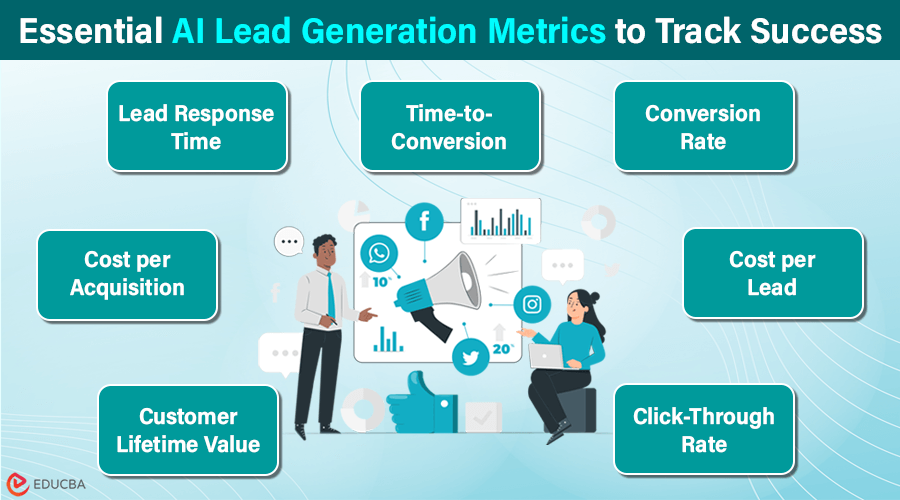
What Does AI Lead Generation Mean?
In AI lead generation, marketers use AI tools like chatbots to target potential customers, increase their interest in your business, and convert them into long-term customers.
AI lead generation is rapidly becoming the go-to approach for marketers because of its human-like cognitive abilities that help improve business processes. It provides marketers with a wealth of data that they can use to identify and target high-value customers. With AI, your campaigns will generate qualified leads who find your products and services valuable enough for them to stick with your business long-term.
But what lead generation metrics should marketers track? The correct data and metrics help you make more informed business decisions and optimize your lead generation strategies for maximum ROI. This article will take you through essential lead generation metrics you must track for business success.
How to Use AI Lead Generation?
With AI technology, you can make your lead-generating processes more efficient and effective. You can generate leads using AI in the following ways:
- Create content for social media marketing that catches the eye of potential customers.
- Automate lead-generating tasks such as data collection, customer segmentation, and content personalization.
- Identify emerging trends and patterns to understand customer needs and wants to create more effective lead generation campaigns.
- Perform lead scoring, where the AI algorithm ranks leads according to their chances of becoming a customer.
- Analyze customer behaviors, purchase history, engagement levels, and other data points to understand what makes up a good lead.
Essential AI Lead Generation Metrics You Must Monitor
AI Lead generation metrics are measurements marketers use to check if their marketing campaigns and strategies are working and helping them attract potential customers or “leads.”
With the increasing complexity of AI tools, you need to track critical metrics to evaluate their performance. Here are some essential lead generation metrics that you should track when using AI:
1. Efficiency Metrics
To evaluate the productivity of your AI approach, analyze the following metrics:
◆ Time-to-Conversion
Time-to-conversion is the period from a potential buyer’s initial interaction to their purchasing decision. Whether you are using landing pages, chatbots, or another lead-generation strategy, the goal is to reduce your time-to-conversion.
AI-powered tools, such as chatbots, can help improve time-to-conversion by providing quick and efficient solutions to queries. They can also offer personalized content based on previous interactions. This way, leads don’t have to manually look for the products they are interested in, which results in better customer engagement and increased satisfaction.
◆ Cost Per Lead (CPL)
Cost per lead tracks the money your sales team spends to acquire a new lead from your target market. AI tools can help reduce CPL by automating routine tasks. For instance, instead of hiring multiple personnel who can manually onboard leads and get their relevant information, you can use AI for this.
Furthermore, AI can predict which leads are most likely to convert based on various factors, including demographics, interests, and behavior. AI sales tools help businesses focus their marketing budget and other resources on the most promising leads, reducing the overall CPL.
◆ Lead Response Time
Lead response time measures the average time the business takes to contact a potential lead. AI can significantly improve lead response time through automation. The ideal response time is within five minutes of the lead’s first interaction with the business. According to a study, waiting for even just 10 minutes can reduce the likelihood of conversion by 400%.
With AI, companies can provide almost real-time feedback to leads. Through smart routing, it can also immediately direct leads to concerned agents, ensuring quicker response times. AI tools can also help you reduce the risk of sending your messages to the wrong person, decreasing lead response time. With an email finder, for instance, you can verify whether the email address submitted by a lead was the correct one.
2. Lead Quality Metrics
To analyze the quality of generated leads, use these metrics:
◆ Conversion Rate
It measures how many conversions you were able to generate while using AI. AI can help boost your conversion rate in many ways. As previously stated, AI gathers user preferences, browsing history, and other factors to offer personalized product recommendations.
Similarly, AI can deliver targeted promotions and offer relevant ones to the user. These timely, customized promotions can entice customers to take your desired action. Finally, AI can process orders quickly and accurately, reducing the time to complete their purchases. It is possible due to a natural language processing (NLP) engine.
◆ Customer Lifetime Value
Customer lifetime value (CLV) is a metric that measures an organization’s profitability by estimating the total income one customer brings to the business over their entire relationship with the company.
AI empowers you to provide proactive customer service. AI-powered chatbots can anticipate customer needs, detect issues, and offer real-time personalized solutions. This kind of exceptional customer service fosters long-term loyalty and positively impacts CLV. Also, AI can enhance CLV by optimizing the customer journey, making it easy for them to stick with your brand.
For instance, Plum, an employee benefits platform in India, used a WhatsApp bot to make it easier for customers to file claims. This reduced claim filing time by 60%.
3. Better-Targeting Metrics
You can use the following metrics to evaluate the accuracy and relevance of reaching intended audiences.
◆ Click-Through Rate (CTR)
Click-through rate is the total number of people that click on your site, product, etc. A high CTR indicates interest and shows that your campaign is generating leads.
Personalization is the primary means through which AI can influence click-through rates. Using AI, you can deliver tailored content to each user based on their data. This tailored content can be delivered in emails, social media posts, and ads, among other formats. With the recent shift to GA4, you can easily see what your visitors do on your site after the click-through and make the necessary improvements to your campaigns.
AI performs A/B testing on vast amounts of data quickly to detect any patterns. This helps you identify which campaign versions work best and target those customers more effectively.
◆ Engagement Rate
It measures how successful AI, like customer service chatbots, is in helping you meet customer needs. AI-powered chatbots use advanced algorithms to understand conversation context and provide relevant solutions to customer queries. Chatbots can accurately identify and respond to user requests, increasing the likelihood of leads staying and interacting with them. According to statistics, 68% of users like how quickly chatbots respond.
Furthermore, AI can create personalized experiences for each user by collecting and analyzing user data. Research by Accenture found that 91% of consumers prefer brands that recognize their needs and offer tailored suggestions. It leads to improved engagement and fosters stronger customer loyalty.
Moreover, AI chatbots can predict user interactions, enabling them to engage and retain users proactively. For example, a chatbot can initiate a customer feedback request after a purchase, prolonging their engagement while acquiring valuable insights.
4. ROI Metrics
Here are the most crucial ROI KPI (key performance indicators) to track:
◆ Cost Per Acquisition (CPA)
It is a key metric that measures the average cost to acquire one paying customer on a campaign or channel level.
The ability of AI-like chatbots to analyze extensive data helps marketers tailor their efforts with greater efficiency. Effective and precise customer segmentation ensures advertisements reach the most relevant audience.
Consequently, precision targeting reduces wasted expenditure on less likely prospects, lowering the overall CPA. Furthermore, AI can automate and optimize bidding in real time, further contributing to cost efficiency.
AI Lead Generation – Overcoming Challenges
AI has enormous potential in lead generation, but it comes with its own set of challenges, such as:
- Requires High-Quality Data: AI algorithms rely heavily on data inputs for accurate predictions. If the data is incomplete, outdated, or inaccurate, the AI model’s output may not be reliable. However, investing in data cleansing and enrichment technologies can ensure that your AI models can access high-quality data.
- Indirect Bias: AI systems can inadvertently reinforce societal biases as they learn from potentially biased data. To mitigate this, utilize diverse training datasets and incorporate bias-detection mechanisms.
- Integration with Existing Systems: When evaluating AI lead generation tools, it is crucial to evaluate their compatibility with existing systems or their customization ability to align with your current setup.
- Limited AI expertise: Implementing AI for lead generation needs you to have special skills that may not be readily available within a business. Utilizing various sources–including data science experts, industry analysts, and artificial intelligence start-ups, can help you manage AI models for lead generation purposes.
As the AI field progresses, new strategies emerge. You should actively stay abreast of these emerging trends so you can optimize the use of AI for lead generation.
Final Thoughts
Understanding the essential AI lead generation metrics when using AI is essential for success. Business owners like you need to know how their AI is helping your lead generation efforts. This way, they can tweak their strategies for the best results. Check your efficiency, lead quality, better-targeting, and ROI metrics. At the same time, implement easy solutions to overcome challenges typically associated with the use of AI.
 Author Bio
Author BioDavid Pagotto founded SIXGUN, a digital marketing agency in Melbourne. He is also the MD of SIXGUN, and he has over a decade of experience in the industry. He has helped many organizations gain more customers, reach, and impact.
Recommended Articles
We hope this article helped you identify the key AI lead generation metrics you must know about. For more information on similar concepts, read the following recommendations.

